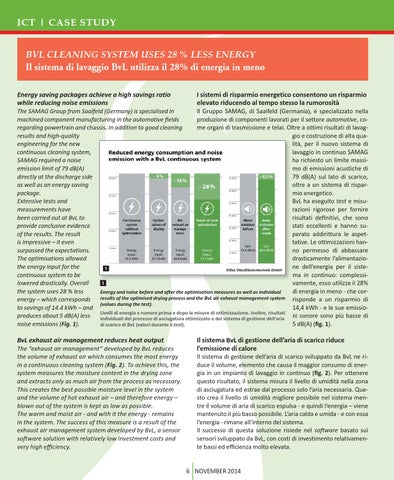ICT
CASE STUDY
BVL CLEANING SYSTEM USES 28 % LESS ENERGY Il sistema di lavaggio BvL utilizza il 28% di energia in meno Energy saving packages achieve a high savings ratio while reducing noise emissions
I sistemi di risparmio energetico consentono un risparmio elevato riducendo al tempo stesso la rumorosità
The SAMAG Group from Saalfeld (Germany) is specialised in Il Gruppo SAMAG, di Saalfeld (Germania), è specializzato nella machined component manufacturing in the automotive fields produzione di componenti lavorati per il settore automotive, coregarding powertrain and chassis. In addition to good cleaning me organi di trasmissione e telai. Oltre a ottimi risultati di lavagresults and high-quality gio e costruzione di alta quaengineering for the new lità, per il nuovo sistema di continuous cleaning system, lavaggio in continuo SAMAG SAMAG required a noise ha richiesto un limite massiemission limit of 79 dB(A) mo di emissioni acustiche di directly at the discharge side 79 dB(A) sul lato di scarico, as well as an energy saving oltre a un sistema di risparpackage. mio energetico. Extensive tests and BvL ha eseguito test e misumeasurements have razioni rigorose per fornire been carried out at BvL to risultati definitivi, che sono provide conclusive evidence stati eccellenti e hanno suof the results. The result perato addirittura le aspetis impressive – it even tative. Le ottimizzazioni hansurpassed the expectations. no permesso di abbassare The optimisations allowed drasticamente l’alimentaziothe energy input for the ne dell’energia per il siste1 ©BvL Oberflächentechnik GmbH continuous system to be ma in continuo: complessi1 lowered drastically. Overall vamente, esso utilizza il 28% the system uses 28 % less di energia in meno - che corEnergy and noise before and after the optimisation measures as well as individual energy – which corresponds results of the optimised drying process and the BvL air exhaust management system risponde a un risparmio di (values during the test). to savings of 14.4 kWh – and 14,4 kWh - e le sue emissioLivelli di energia e rumore prima e dopo le misure di ottimizzazione. Inoltre, risultati produces about 5 dB(A) less individuali del processo di asciugatura ottimizzato e del sistema di gestione dell’aria ni sonore sono più basse di noise emissions (Fig. 1). 5 dB(A) (fig. 1). di scarico di BvL (valori durante il test).
BvL exhaust air management reduces heat output The “exhaust air management” developed by BvL reduces the volume of exhaust air which consumes the most energy in a continuous cleaning system (Fig. 2). To achieve this, the system measures the moisture content in the drying zone and extracts only as much air from the process as necessary. This creates the best possible moisture level in the system and the volume of hot exhaust air – and therefore energy – blown out of the system is kept as low as possible. The warm and moist air - and with it the energy - remains in the system. The success of this measure is a result of the exhaust air management system developed by BvL, a sensor software solution with relatively low investment costs and very high efficiency.
Il sistema BvL di gestione dell’aria di scarico riduce l’emissione di calore Il sistema di gestione dell’aria di scarico sviluppato da BvL ne riduce il volume, elemento che causa il maggior consumo di energia in un impianto di lavaggio in continuo (fig. 2). Per ottenere questo risultato, il sistema misura il livello di umidità nella zona di asciugatura ed estrae dal processo solo l’aria necessaria. Questo crea il livello di umidità migliore possibile nel sistema mentre il volume di aria di scarico espulsa - e quindi l’energia – viene mantenuto il più basso possibile. L’aria calda e umida - e con essa l’energia - rimane all’interno del sistema. Il successo di questa soluzione risiede nel software basato sui sensori sviluppato da BvL, con costi di investimento relativamente bassi ed efficienza molto elevata.
6 NOVEMBER 2014
